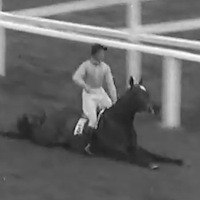The Battle of Alcatraz (May 2-4, 1946)

In the early part of the 20th Century, when a prisoner at a maximum security prison—such as San Quentin or Leavenworth—misbehaved, there was one place they would go: Alcatraz.
In the 1850’s, Alcatraz Island became the prime location for a military Citadel. The West Coast of the country needed protection and the Gold Rush in California caused a notable increase in the population of San Francisco. Along with two other forts, Fort Alcatraz formed a triangle of defense in the Bay area and had the proud of honour of having the first West Coast lighthouse built on it.
The defensive nature of the structure, however, soon waned in the later part of the decade. Instead of firing guns and cannons, it housed military prisoners. The bastion of the Pacific transformed into the nightmare of a Penitentiary. In 1909, the military prisoners housed on the island were instructed to tear down the Citadel to the basement, then rebuild the prison that would become known as “The Rock.”
In 1933, the Army transferred possession of the prison to the Federal Government. Now a part of the US Department of Justice, Alcatraz would play host to a bevy of notorious gangsters and murderers of the 1920’s and 1930’s—as well as the lesser knowns from other maximum security prisons—as proof to the American public that the Government was serious about cutting out crime.
“The Rock” became known as inescapable—impenetrable. During the 29 years it operated as a Federal penitentiary, there were 14 separate escape attempts, one of which left three prisoners and two guards dead, and one other prisoner and fourteen correctional officers wounded. Six men orchestrated the events that would become known as the Battle of Alcatraz.
On the morning of May 2, 1946, Paul Bernard Coy awoke with malicious thoughts afoot in his head. For some time, Coy observed the habits of certain guards around Alacatraz—where they stationed themselves, when they went to the restroom or for a smoke break, etc. He and five other men planned a daring escape that, if successful, would launch them into history as the first to successfully escape The Rock. On that 2nd day of May, Coy smeared axel grease on his face, arms, legs, and chest and with fellow inmate Joseph Paul Cretzer as look out, began climbing the West End Gun Gallery. Once on top of the barred cage, Coy produced a home-made bar spreader and spread the bars from their normal 5-inch width to a 10-inch width, then lowered himself through them.
Once inside the Gun Gallery, Coy had access to all the weaponry he could possibly need. He grabbed a single riot club, then lay in wait for the guard. His accomplices led the guard out and Coy clubbed him down, then strangled him into unconsciousness. With the on-duty guard out of the way, Coy began to lower weapons of various kinds to Cretzer, Marvin Franklin Hubbard, Miran Edgar Thompson, Clarence Carnes, and Sam Richard Shockley.
The team overpowered nine unarmed guards and locked them in containment cells. The only thing—in their minds—that stood between them and freedom was the key to the Recreation Yard. Coy demanded the keys from Officer Miller, who gladly surrendered all the keys, except the key to the recreation yard, which he silently hid in the toilet fixture of the cell.
With the breakout detected, the sirens began to wail, alerting the shore of trouble. The Marines and Coast Guard began making their way toward the island. The rest of the correctional officers ushered the inmates that could not return to their cellblock into the recreation yard to keep them safe. Realizing their escape was thwarted, Cretzer began firing his revolver into cell #403 where several of the guards were located.
The Warden tried to organize a counter-attack on the men to subdue them, but all that ended up happening from his attempts was the death of Officer Stites who fought valiantly during the riot. The Associate Warden led a team of fourteen officers into the Gallery and was met by a volley of gunfire from above. The inmates had climbed to the upper level of C-Block and were raining fire down upon the officers below. One of the officers managed to close off access to D-Block by closing the door, and was shot in the shoulder during the process. The would-be escapees began to realize they weren’t going anywhere. Thompson and Shockley crawled back to their cells to formulate explanations for their involvement in the ordeal.
C-Block, at the time of the escape attempt, was empty. The inmates were outside on duties. D-Block, however, was still populated. When the Marines arrived, they had no idea where the gunfire originated and began bombing…D-Block. The inmates were cowering behind overturned beds and soaking wet mattresses because the sprinkler system had engaged. D-Block quickly began to flood. Robert Stroud, then 56 years old, lowered himself from the third tier of D-Block to the second, then to the floor to close the heavy iron doors in front of the containment unit. He yelled up to the officer in charge, Officer Bergen, explaining there were no firearms in D-Block and that the men responsible had escaped to another part of the prison.
The barrage continued for 48 hours. When the dust settled and the smoke cleared, Coy, Hubbard, and Crezter were found dead from bullet and/or shrapnel wounds. Officer William Miller—the man responsible for hiding the needed key—had been killed, as well as Officer Stites. Only three men remained alive—Carnes, Thompson, and Shockley. Carnes had showed some degree of compassion toward the imprisoned guards, so for such compassion, he received a light sentence of 99 additional years for his involvement. Carnes, at the time of the attempt, was 19. Shockley and Thompson, however, did not receive such leniency. Both were gassed at San Quentin on December 3, 1948.
In the 1850’s, Alcatraz Island became the prime location for a military Citadel. The West Coast of the country needed protection and the Gold Rush in California caused a notable increase in the population of San Francisco. Along with two other forts, Fort Alcatraz formed a triangle of defense in the Bay area and had the proud of honour of having the first West Coast lighthouse built on it.
The defensive nature of the structure, however, soon waned in the later part of the decade. Instead of firing guns and cannons, it housed military prisoners. The bastion of the Pacific transformed into the nightmare of a Penitentiary. In 1909, the military prisoners housed on the island were instructed to tear down the Citadel to the basement, then rebuild the prison that would become known as “The Rock.”
In 1933, the Army transferred possession of the prison to the Federal Government. Now a part of the US Department of Justice, Alcatraz would play host to a bevy of notorious gangsters and murderers of the 1920’s and 1930’s—as well as the lesser knowns from other maximum security prisons—as proof to the American public that the Government was serious about cutting out crime.
“The Rock” became known as inescapable—impenetrable. During the 29 years it operated as a Federal penitentiary, there were 14 separate escape attempts, one of which left three prisoners and two guards dead, and one other prisoner and fourteen correctional officers wounded. Six men orchestrated the events that would become known as the Battle of Alcatraz.
On the morning of May 2, 1946, Paul Bernard Coy awoke with malicious thoughts afoot in his head. For some time, Coy observed the habits of certain guards around Alacatraz—where they stationed themselves, when they went to the restroom or for a smoke break, etc. He and five other men planned a daring escape that, if successful, would launch them into history as the first to successfully escape The Rock. On that 2nd day of May, Coy smeared axel grease on his face, arms, legs, and chest and with fellow inmate Joseph Paul Cretzer as look out, began climbing the West End Gun Gallery. Once on top of the barred cage, Coy produced a home-made bar spreader and spread the bars from their normal 5-inch width to a 10-inch width, then lowered himself through them.
Once inside the Gun Gallery, Coy had access to all the weaponry he could possibly need. He grabbed a single riot club, then lay in wait for the guard. His accomplices led the guard out and Coy clubbed him down, then strangled him into unconsciousness. With the on-duty guard out of the way, Coy began to lower weapons of various kinds to Cretzer, Marvin Franklin Hubbard, Miran Edgar Thompson, Clarence Carnes, and Sam Richard Shockley.
The team overpowered nine unarmed guards and locked them in containment cells. The only thing—in their minds—that stood between them and freedom was the key to the Recreation Yard. Coy demanded the keys from Officer Miller, who gladly surrendered all the keys, except the key to the recreation yard, which he silently hid in the toilet fixture of the cell.
With the breakout detected, the sirens began to wail, alerting the shore of trouble. The Marines and Coast Guard began making their way toward the island. The rest of the correctional officers ushered the inmates that could not return to their cellblock into the recreation yard to keep them safe. Realizing their escape was thwarted, Cretzer began firing his revolver into cell #403 where several of the guards were located.
The Warden tried to organize a counter-attack on the men to subdue them, but all that ended up happening from his attempts was the death of Officer Stites who fought valiantly during the riot. The Associate Warden led a team of fourteen officers into the Gallery and was met by a volley of gunfire from above. The inmates had climbed to the upper level of C-Block and were raining fire down upon the officers below. One of the officers managed to close off access to D-Block by closing the door, and was shot in the shoulder during the process. The would-be escapees began to realize they weren’t going anywhere. Thompson and Shockley crawled back to their cells to formulate explanations for their involvement in the ordeal.
C-Block, at the time of the escape attempt, was empty. The inmates were outside on duties. D-Block, however, was still populated. When the Marines arrived, they had no idea where the gunfire originated and began bombing…D-Block. The inmates were cowering behind overturned beds and soaking wet mattresses because the sprinkler system had engaged. D-Block quickly began to flood. Robert Stroud, then 56 years old, lowered himself from the third tier of D-Block to the second, then to the floor to close the heavy iron doors in front of the containment unit. He yelled up to the officer in charge, Officer Bergen, explaining there were no firearms in D-Block and that the men responsible had escaped to another part of the prison.
The barrage continued for 48 hours. When the dust settled and the smoke cleared, Coy, Hubbard, and Crezter were found dead from bullet and/or shrapnel wounds. Officer William Miller—the man responsible for hiding the needed key—had been killed, as well as Officer Stites. Only three men remained alive—Carnes, Thompson, and Shockley. Carnes had showed some degree of compassion toward the imprisoned guards, so for such compassion, he received a light sentence of 99 additional years for his involvement. Carnes, at the time of the attempt, was 19. Shockley and Thompson, however, did not receive such leniency. Both were gassed at San Quentin on December 3, 1948.

Related Articles
Editor's Picks Articles
Top Ten Articles
Previous Features
Site Map
Content copyright © 2023 by Christa Mackey. All rights reserved.
This content was written by Christa Mackey. If you wish to use this content in any manner, you need written permission. Contact Lane Graciano for details.







